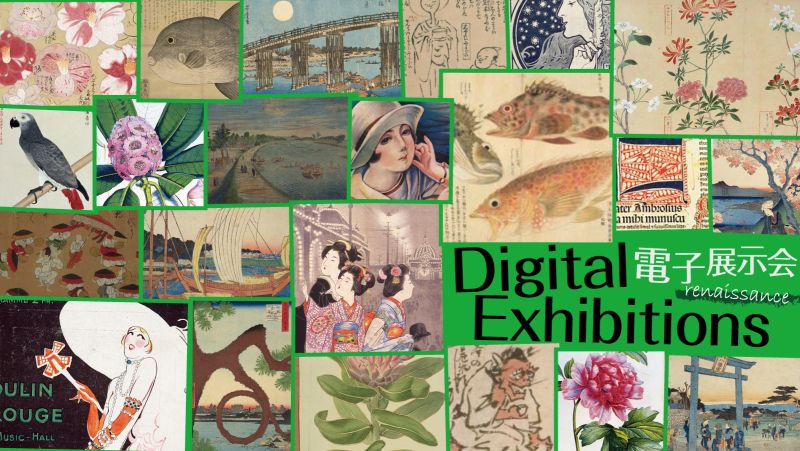New Year's Greeting -New Year's Hikifuda-

There are many ways to prepare good luck charms for the new year. This webpage presents a selection of Hikifuda, advertising flyers distributed in stores until around the Taisho period (1912-1926), especially for New Year's. Hikifuda means a woodblock print distributed to "attract" customers or a woodblock print that "pulls" customers into the store. Therefore, New Year's Hikifuda were printed in rich colors with congratulatory drawings of the store's location and name, etc., and were distributed at the end of the year and beginning of the year when store owners visited their customers in the neighborhood with greetings.
As you can see in the figure above, a New Year's Hikifuda has two parts: one with the image and the other with the location and the store's name. The artist, who received an order to create Hikifuda, drew a basic sketch, engraved, and printed the woodblock prints of Hikifuda. The collection of those Hikifuda was sold as "Mihoncho (sample books)" to printers throughout the country, and stores would select an image from Mihoncho and order it to the printer. The artists who drew basic sketches include ukiyo-e artists, Japanese-style painters, and painters who drew frontpieces of magazines.
The Hikifuda above has the artist's name, "Kanmei", and his signature stamped on it.
Next, this web page will introduce the details of the images drawn on the New Year's Hikifuda. There are a wide variety of images, including those of the Seven Lucky Gods, Fukusuke, Otafuku, and objects of worship with spiritual power.
The left figure is Hikifuda depicting Fukusuke, the god of fortune; the central figure is Hikifuda depicting Ebisu and Daikoku, the gods of business prosperity and supply of goods and wealth; and the right figure is Hikifuda depicting Izanagi and Izanami from Japanese mythology. Many Hikifuda depicting Ebisu and Daikoku, the gods of good fortune, have been made. This is because these two gods are the gods of good fortune related to business.
Next, let's look at some images of flowers and birds.
The left image depicts a pine tree, hawk, and the morning sun; the center image depicts a pine tree, cranes, and the morning sun; and the right image depicts Mt. Fuji, cranes, and the morning sun. These paintings depict two of the three lucky new year dreams: Fuji, Falcon, and Eggplant (ichi Fuji, ni taka, san nasubi). Also, pine and crane are auspicious paintings with the theme of eternal youth and longevity called "Shokaku choshun". The first sunrise is a festive subject for painting, with the appearance of Toshigami, a Shinto god visiting homes every New Year's Day, at the same time.
Finally, let's see some Hikifuda, which puts meaning into the pictures.
The left image depicts Ebisu and Daikoku, the center image Ebisu and a treasure ship, and the right image is a child and a golden tree. The left image depicts Ebisu and Daikoku harvesting seaweed on a small boat, playing with words using the homonym "mo wo karu (harvesting seaweed)" for "mokaru (making money)" to bring good luck. A "simplified chart of postage rates" is depicted at the top of the central image. The simplified chart in the image reflects the store's intention to have their customers the New Year's Hikifuda posted around their houses for use in daily life. Finally, the golden tree shown on the left is depicted as a bonsai tree placed as a New Year's decoration, with the hope that money will grow like a child's growth.
In modern times, the custom of distributing calendars with company names on them as greetings during the year-end and New Year holidays is a remnant from the days of the Hikifuda.
